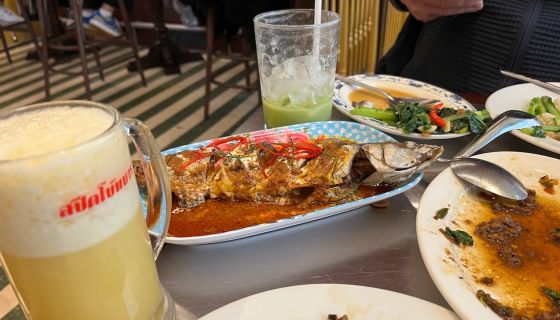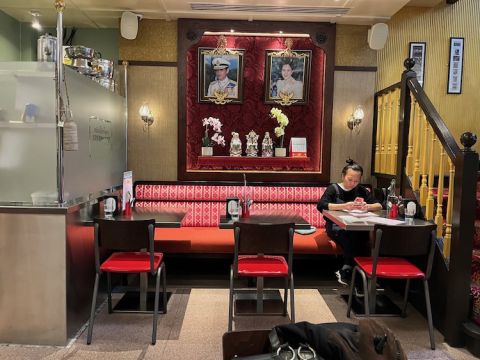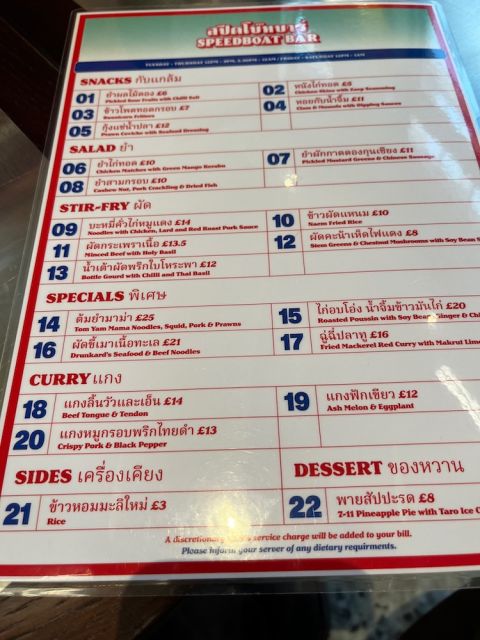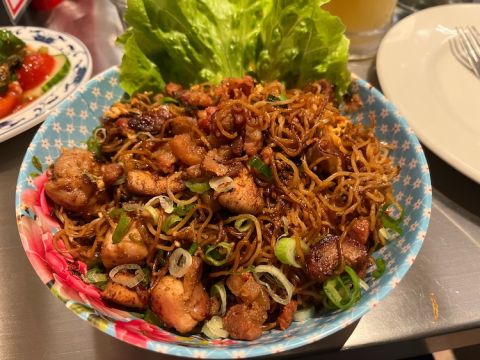The evidence for this trend is now quite clear. There are the queues outside Dishoom (over 60-strong outside the King’s Cross branch one chilly night this week), where the appeal of their Indian breakfast generates long queues from 8.45 am at the weekends. The increasing popularity of Sri Lankan food has played a part, as well as the proliferation of Thai restaurants that have taken over a growing number of traditional British pubs.
The first of these was The Churchill Arms, in London’s Kensington High Street, which began for a trial month in July 1988. In January 2009 I wrote about one of the synergies that make this phenomenon happen. ‘The kitchen at The Churchill Arms is considerably smaller than many domestic ones yet because it focuses today on quickly cooked, one-plate dishes, it can serve a very large number of customers.’
Then there is the fashion/passion for the spicy cooking of West Africa, notable in the success of Ikoyi, which will shortly reopen in new surroundings at 180 The Strand. This is aiming very high with an opening set menu priced at £300 per head (there is a shorter lunch menu on Wednesday and Friday at £180!), which is twice the price of the set dinner menu at two-star A Wong, where we ate and were entertained extremely well a fortnight ago. The popularity of Din Tai Fung and the spicy nature of much of the food on offer at JKS’s Arcade Food Hall on New Oxford Street only add to this trend (a trend that can be seen even at the high-street bakery chain Gail’s, where their Christmas smoked-turkey sandwich this year now comes with a chipotle aioli).
The most obvious example of this transformation became clear to me when I arranged to have lunch with Peter Harden, the editor of Harden’s restaurant guides, at 30 Rupert Street in Soho. What had opened here in 2017 used to trade as Xu Teahouse and Restaurant, another JKS- backed restaurant. (The three siblings behind JKS also own the BAO group of casual restaurants named after the Chinese filled buns.) Today it is the Speedboat Bar and Restaurant specialising in Thai food. The change from Chinese to Thai food, albeit inspired by Yaowarat Road, the main thoroughfare of Bangkok’s Chinatown, is as significant as the change in the title from teahouse to bar. What led to the change?
I had to start with JKS, who would have signed the lease on this site, and from whom I received the following statement in answer to my questions:
‘Xu was profitable and critically well-received, but it struggled to find its rhythm in Chinatown. Then during COVID, the BAO team made the decision to focus on the development of the BAO brand with the opening of King’s Cross (December 2020) and Shoreditch (June 2021), so the site never reopened as Xu after March 2020.
‘Before we opened it as Speedboat Bar, it actually became Viet Populaire, a bánh mì sandwich pop-up which ran for seven successful weeks from 29 October 2021.
‘Speedboat Bar is very much Luke Farrell’s vision and showcases Thai food through the prism of Bangkok’s Chinatown. It wasn’t down to Thai food being considered less esoteric or more popular when it came to opening Speedboat Bar on Rupert Street, rather it was a question of Karam Sethi (the K of JKS) meeting Luke Farrell (the grower of Asian ingredients and the partner in Plaza Khao Gaeng) and embarking on a journey to bring his concept to life.
‘Audience-wise, they have seen a large contingent of both the Thai and Chinese community visiting since opening. The Thai community in particular have enjoyed the feeling of home at Speedboat.’
The latter observation is not surprising because the interior has received a major transformation. Out have gone the dark wood and red coverings that seem synonymous with Chinese restaurants and in have come the much brighter colours associated with the sunshine of Thailand. There is lots of yellow on the walls and the carpet that leads to the first floor, the tables are bare metal, the chairs have a shiny red covering, one wall downstairs is hung with photos of the Thai royal family, while upstairs the lavatories have been significantly brightened up. The waiters are in colourful blue-and-white T-shirts with one sporting a beard and matching tweed cap and trousers when I was there. A speedboat hangs above diners on the first floor.
The drinks and food menu are, annoyingly, printed on laminated plastic and are as brightly coloured as the rest of the interior. The menu is broken down into seven sections all printed in red and white: snacks, salads, stir-fries, specials (not obviously that special), curries, sides and dessert. And just to make sure that there are no mistakes, all the dishes are numbered.
We began with an order of crisp sweetcorn fritters before four shared main courses: a dish of minced beef with holy basil and, the best dish of all, from the specials section, mackerel in a red curry that was lip-smackingly good. These were then followed by two more curries, of beef tongue and tendon and of ash melon (white gourd) and eggplant (aubergine). These two curries worked well together, the sauce with the beef thick and creamy whereas the sauce with the vegetables was much cleaner and lighter. We enjoyed, but limited ourselves to, a couple of mouthfuls of their one dessert, an ultra sweet 7-11 pineapple pie with taro ice cream, before I paid the bill of £120 for two, including three drinks.
The drink I enjoyed is described as a ‘jelly bia’, a mixture of ginger, Thai honey and calamansi (Philippine lime or lemon) mixed with a frozen Singha beer. It proved so addictive that I found myself ordering it again on my second visit. I enjoyed it as much on this occasion, together with a bowl of stir-fried noodles with chicken, lots of the more flavourful dark meat, topped with a roast pork sauce. The dish was so spicy that it tingled the inside of my mouth for a good 45 minutes, although it was somewhat cooled by a side dish of pickled mustard greens and Chinese sausage.
This second time I was sitting elsewhere on the ground floor and could appreciate quite how difficult this building is to operate as a restaurant. There is only one entrance and exit via swing doors at the front so that everyone has to stop when a delivery arrives, as I had to do when my arrival coincided with a delivery of four large boxes. The kitchen is in the basement, linked by an electric dumb waiter which goes only as far as the ground floor from where all the food has to be carried upstairs up a quite steep set of stairs. To be a waiter here you must be pretty fit.
As such, and located in an extremely busy area of London, this new identity suits the building far more than its previous incarnation. It is bright and sunny, with everything, including the food, designed to put a smile on your face. And as for its name, the substitution of the word bar for tea room is bound to appeal to a younger crowd.
Speedboat Bar 30 Rupert Street, London W1D 6DL; open until 1 am Friday and Saturday, midnight otherwise, closed Sunday.

















